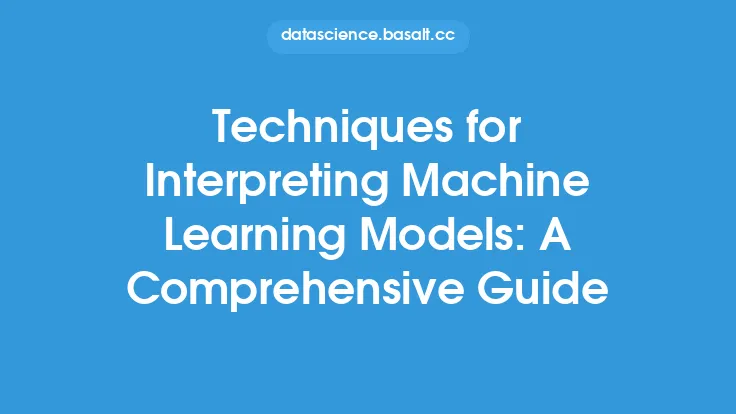Hyperparameter tuning is a crucial step in the machine learning workflow, as it can significantly impact the performance of a model. Hyperparameters are parameters that are set before training a model, and they can have a significant impact on the model's ability to generalize to new data. In this article, we will provide a comprehensive guide to hyperparameter tuning techniques, including the different types of hyperparameters, the challenges of hyperparameter tuning, and the various techniques that can be used to optimize hyperparameters.
Introduction to Hyperparameters
Hyperparameters are parameters that are set before training a model, and they can have a significant impact on the model's performance. Examples of hyperparameters include the learning rate, regularization strength, and number of hidden layers in a neural network. Hyperparameters can be categorized into several types, including model hyperparameters, which define the architecture of the model, and training hyperparameters, which define the training process. Model hyperparameters include the number of hidden layers, the number of units in each layer, and the activation functions used in each layer. Training hyperparameters include the learning rate, batch size, and number of epochs.
Challenges of Hyperparameter Tuning
Hyperparameter tuning can be challenging due to the large number of possible hyperparameter combinations and the computational cost of training a model. The number of possible hyperparameter combinations can be extremely large, making it difficult to search the entire space. Additionally, training a model can be computationally expensive, making it difficult to evaluate multiple hyperparameter combinations. Furthermore, hyperparameter tuning can be sensitive to the choice of hyperparameters, and small changes in hyperparameters can result in large changes in model performance.
Hyperparameter Tuning Techniques
There are several hyperparameter tuning techniques that can be used to optimize hyperparameters. These techniques can be categorized into two main categories: traditional techniques and advanced techniques. Traditional techniques include grid search, random search, and manual tuning. Grid search involves searching the entire hyperparameter space by training a model on all possible hyperparameter combinations. Random search involves randomly sampling the hyperparameter space and training a model on each sampled combination. Manual tuning involves manually setting hyperparameters based on experience and expertise.
Advanced Hyperparameter Tuning Techniques
Advanced hyperparameter tuning techniques include Bayesian optimization, gradient-based optimization, and evolutionary algorithms. Bayesian optimization involves using a probabilistic model to search the hyperparameter space. Gradient-based optimization involves using gradient descent to search the hyperparameter space. Evolutionary algorithms involve using evolutionary principles, such as natural selection and mutation, to search the hyperparameter space. These techniques can be more efficient and effective than traditional techniques, but they can also be more complex and require more expertise.
Model-Based Hyperparameter Tuning
Model-based hyperparameter tuning involves using a model to predict the performance of a model on a given set of hyperparameters. This can be done using a surrogate model, such as a Gaussian process or a neural network, to predict the performance of the model. The surrogate model can be trained on a set of hyperparameter combinations and their corresponding model performances. Once the surrogate model is trained, it can be used to predict the performance of the model on new hyperparameter combinations, allowing for more efficient hyperparameter tuning.
Hyperparameter Tuning for Deep Learning Models
Hyperparameter tuning for deep learning models can be particularly challenging due to the large number of hyperparameters and the computational cost of training a deep learning model. However, there are several techniques that can be used to optimize hyperparameters for deep learning models, including learning rate schedulers, batch normalization, and hyperparameter tuning libraries. Learning rate schedulers can be used to adjust the learning rate during training, allowing for more efficient convergence. Batch normalization can be used to normalize the inputs to each layer, allowing for more stable training. Hyperparameter tuning libraries, such as Hyperopt and Optuna, can be used to automate hyperparameter tuning for deep learning models.
Hyperparameter Tuning for Transfer Learning
Hyperparameter tuning for transfer learning involves tuning the hyperparameters of a pre-trained model on a new dataset. This can be challenging due to the difference in datasets and the need to adapt the pre-trained model to the new dataset. However, there are several techniques that can be used to optimize hyperparameters for transfer learning, including fine-tuning, feature extraction, and hyperparameter tuning libraries. Fine-tuning involves training the pre-trained model on the new dataset with a small learning rate, allowing for adaptation to the new dataset. Feature extraction involves using the pre-trained model as a feature extractor and training a new model on the extracted features. Hyperparameter tuning libraries can be used to automate hyperparameter tuning for transfer learning.
Conclusion
Hyperparameter tuning is a crucial step in the machine learning workflow, and it can significantly impact the performance of a model. There are several hyperparameter tuning techniques that can be used to optimize hyperparameters, including traditional techniques, advanced techniques, model-based hyperparameter tuning, and hyperparameter tuning for deep learning models and transfer learning. By understanding the different types of hyperparameters, the challenges of hyperparameter tuning, and the various techniques that can be used to optimize hyperparameters, machine learning practitioners can improve the performance of their models and achieve better results.





